Brewster Buffalo B339E – Malaya 1941
December 1941 was not a good time to be in Malaya or Singapore. When the Japanese invaded on 8 December, Geoff Fisken, a former farmer from Gisborne, New Zealand, went into action with No 243 (RAF) Squadron. No 243 was equipped with Brewster Buffalos at that time, and Fisken's usual mount was W8147, coded as WP-O.
Geoff Fisken fought in the skies over Malaya and Singapore until 6 February 1942 when he was badly injured during a dogfight with two Japanese fighters. He was medically evacuated to New Zealand just before Singapore fell, and later fought in P40s in the Solomons, finishing his war with 11 confirmed kills. He is regarded as the highest-scoring British Commonwealth ace in the Pacific theatre. He passed away on June 11 2011.
The model is pretty much OOB from the 1/32 Special Hobby kit. From what I can gather, these aircraft were not exactly in mint condition in terms of their external finish, so I got a bit heavy-handed with the paint fading and chipping. Anyway, the resulting model represents an homage from an old Aussie fighter jock to a Kiwi great.
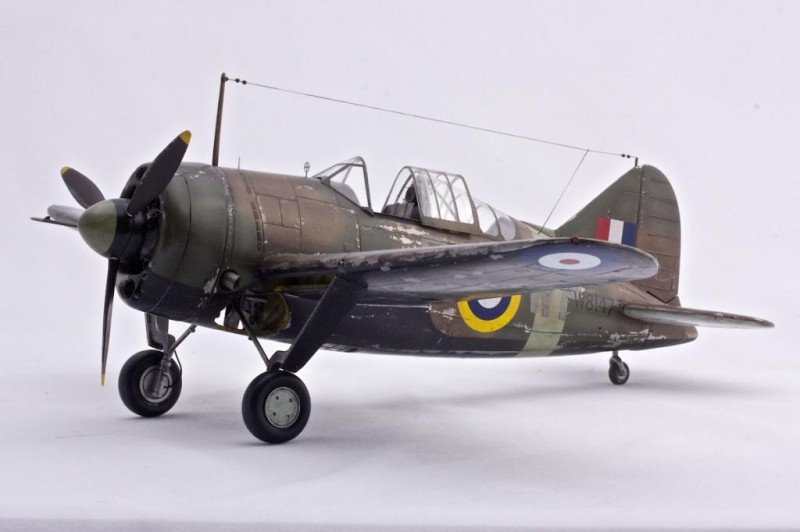
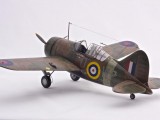
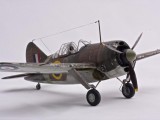
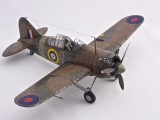
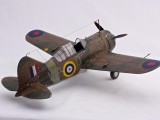
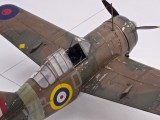
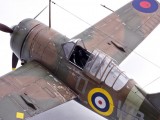
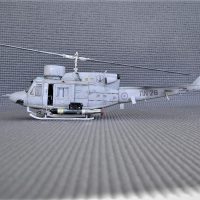
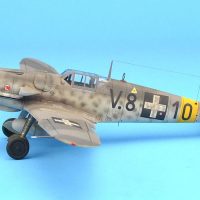
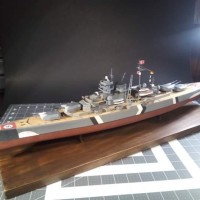
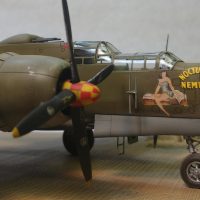
The Buffalo , in my opinion, is a cool looking little aircraft> I especially like them in RAF or Finnish schemes. Your Buffalo is outstanding, especially the paint job and weathering.
Nice build, I find the Buffalo to be beautifully ugly. I have a kit one also and want to build one in early war American. Beautiful work on yours!
Very nice work, with a realistic final result. Most of the photos I have seen of the Buffalo in Singapore and Rangoon, they looked just this way. Had the Commonwealth pilots been able to fight them the way the AVG fought their P-40s, they might have had a better chance, but the RAF high hat in Rangoon said he would court-martial any pilot seen diving away from a fight.
The B-239 is what you get when you add weight without increasing power.
Gotta agree with the masses, sir...you did a nice job on that one in every way.
I love these little aircraft there "ugly /attractive", very nice job on your build.
N.
Great job. Very nice. 🙂
Excellent build. Love the weathering. Good to see something from SEA theatre.
Wonderful aircraft, fantastic built, especially the wear. It looks like if the engine was still hot ...
May we get a picture of the cockpit and the engine?
Very good looking build. I like the worn appearance. My understanding is that equipment in this theater deteriorated quickly due to the harsh environment.
Well done sir, an excellent job .
Looks the part.
Excellent job on this ugly little plane, your paint and your weathering are marvelous,
Eric from France
Nice clean build.
Ugly and beautiful all captured in this model very well, good job!
Nice to see something different, especially when it looks this good. Thanks for posting.
Love it or hate it you have made a stunning job of this one!
and i dont suppose the build was easy going either having had experience with Special Hobby kits,
the weathering looks just right to me well done!
Mark 😉
KJ,
what else can be said or that I could add that has not already been said. I like the Buffalo and yours is outstanding. I had occasion to talk to a number of F4F pilots and their opinion of the Buffalo was good with exceptions. They said it was nice to fly but overall could not compare with the F4F. It still is a neat looking airplane to me and your model is inspiration for me to drag out a kit and do one soon. However in 1/48. Great job.
Thank you for the kind words, Frank.
I've read quite a few negative comments about the Buffalo in my time, so it was interesting to watch a TV interview with Geoff Fisken, a few years back, in which he expressed a genuine fondness for the aircraft. And of course the Finns had a lot of success with it.
The reason Fisken liked the Buffalo was he had enough time in it to figure out what it could and couldn't do. He managed to deliver almost all the Buffalos to the various squadrons as they were assembled and did many of the first flight tests, being one of the first pilots to qualify on the airplane. Thus, by his logbook, he had about 300 hours in the Buffalo by the time of the Japanese attack, while the rest of the pilots had anywhere from 15-45 hours in it, depending on when they got there. Inexperienced pilots in an airplane with a very poor power-to-weight ratio, up against experienced pilots in airplanes with excellent power-to-weight ratios, is pretty much a guaranteed negative outcome. As happened. It didn't help that the reworked DC-3 engines they had were unreliable and that they hadn't had enough ammo to engage in any gunnery training before going up against the Japanese.
So nice to see a real work of art. Gives us in the rank and file something to try and accomplish, but alas, not all of us are gifted with a good eye, steady hand and the patience to bring it all together. Have to agree with Mr. Cleaver about tactics. Chennault taught his AVG pilots to dive, shoot and dive some more but never get into a turning fight with a Zero. Don't know that the final outcome would have been any different though. Every historical account I've read gave the Japanese an huge numerical advantage along with the lack of a consistent early warning system and, well..
Beautiful work..